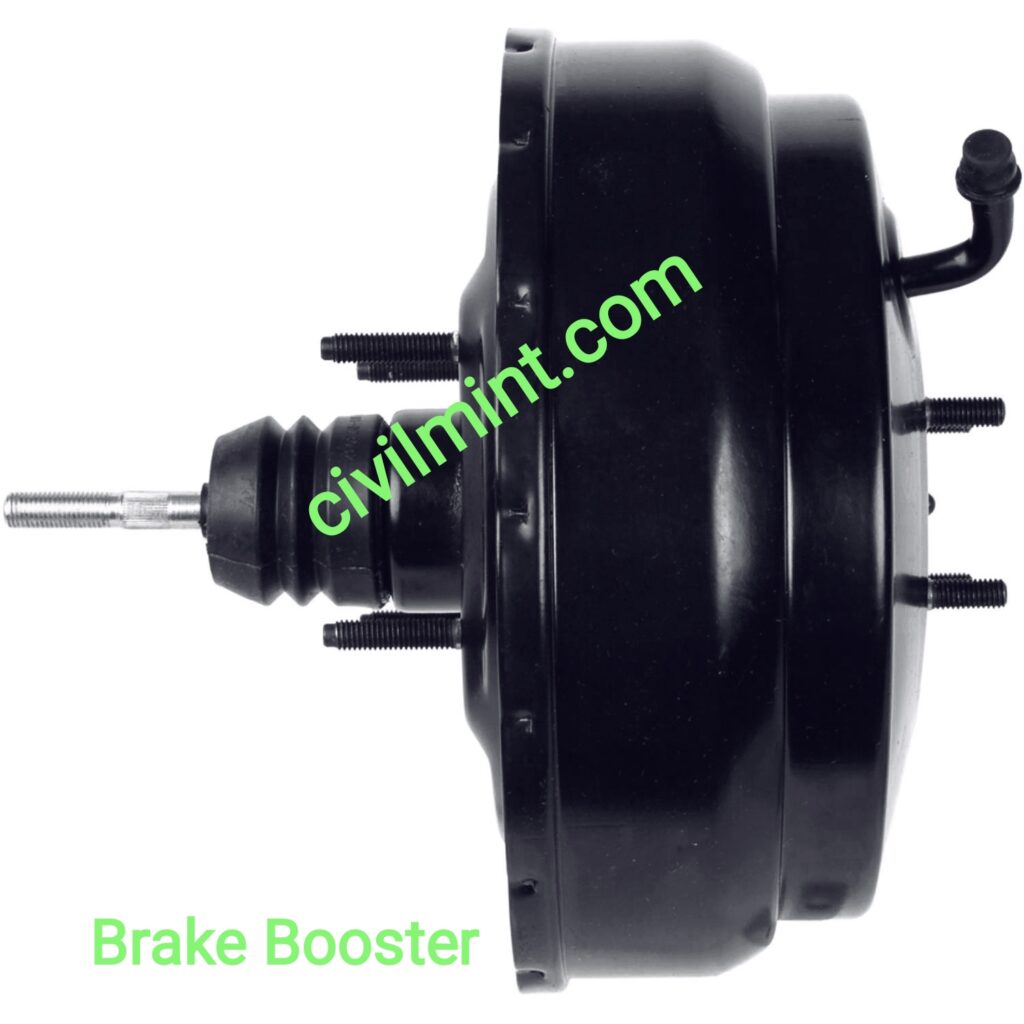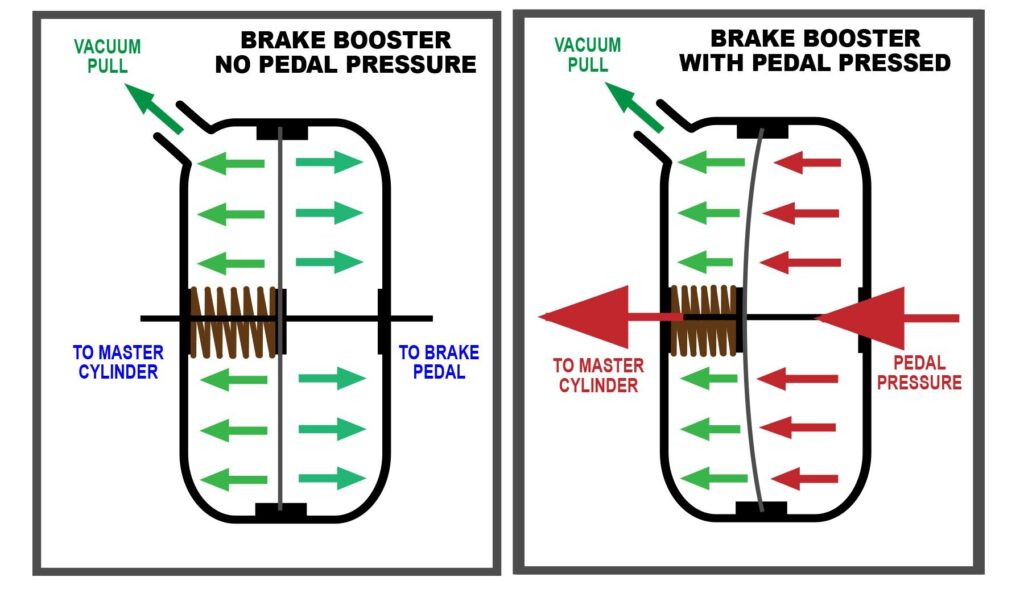Table of Contents
What is Brake Booster?
A brake booster makes braking easier for the driver by increasing the force applied without adding additional force to the foot pedal. This effect is achieved through the use of a vacuum system. This increases pressure on the master cylinder of the brake pedal lever, which increases pressure on the brakes. Brake booster also called as vacuum servo or vacuum booster.

It supports the entire braking system by ensuring that the brake pads are clamped properly and with sufficient force. There are many different types of boosters available today, some of the most popular being double piston master cylinders, vacuum boost brakes, double diaphragm vacuum boost brakes, hydro boost brakes and electric hydro boost brakes. Which of these are included in your vehicle depends on the size and year of your vehicle. However, the most classic model is the standard vacuum booster.
How Does Brake Booster Work?
A brake booster is a safety device used for braking that operates on the principle of Pascal’s law. Since your main task while driving is to control speed and brakes, it helps make driving very comfortable. With the help of this device, the braking experience has completely changed as the human effort required to apply the brakes is reduced.

Installed between the master brake cylinder and brake pedal. A brake booster increases pressure before it is sent to the master cylinder to reduce driver effort. Or we can say that the application of negative pressure created by the engine’s piston and cylinder arrangement doubles the driver’s force on the brake pedal. Braking efficiency is improved and braking effort is greatly reduced, resulting in less driver fatigue and a more comfortable driving experience.
Parts of Brake Booster
1. Body:
The body is the main part with all the components in order. It is the external casing of the brake booster that protects the internal parts from impacts and collisions.
2. Shaft:
Shaft connects between input and output. He has two types of shafts used in brake boosters. One is called the input or primary shaft and the other is the secondary or output shaft. The input shaft connects the input brake pedal and the diaphragm. The function of this shaft is to open and close the intake valves for atmospheric intake and exhaust. A secondary or output shaft provides the connection between the diaphragm and the master cylinder. The function of the secondary shaft is to transmit the power generated from the diaphragm to the master cylinder.
3. Valve:
The valve plays an important role in the function of the brake booster. Proper intake and exhaust are required to control and maintain accurate pressure. Two valves equal to the shaft are used here. One is the atmospheric pressure valve and the second is the vacuum valve. The function of both valves is the same, but the vacuum valve is used to maintain a vacuum in the brake booster and is only unidirectional as it does not allow air to flow in and only allows air to flow out.
When the brake pedal is pressed and released, the atmospheric pressure valve allows atmospheric pressure to enter and exit the brake booster. A vacuum valve is installed on the exhaust side of the brake booster and maintains a perfect vacuum by restricting air flow into the brake booster.
4. Diaphragm:
It is the main component of the brake booster as it separates the primary and secondary sides of the brake booster and applies air pressure to transfer motion from the inlet shaft to the outer shaft.
5. Springs:
Single brake boosters use two springs on each side. The size of the spring depends on the size of the brake booster. The main function of the spring is to adjust the position of the valve, and with the help of the spring the valve returns to its original position when the pedal is released.
Bad Brake Booster Symptoms
Knowing the symptoms of a bad brake booster can help you avoid vehicle accidents and costly car repairs. A brake booster is an integral part of a car’s braking system, but what’s so special about it? Reduces the effort required to apply So you don’t have to run around with a bad brake booster. In addition to damage to your vehicle, it is extremely dangerous for you and other road users.
So the question “Can I drive with a bad brake booster?” never arises. Experts believe that by paying attention to certain signs, many problems resulting from a bad brake booster can be avoided. However, as soon as you notice any of the following signs, it is highly likely that your brake booster is bad.
I have described various symptoms of bad brake booster.
1. Lock hard brake pedal
One of the most common signs of a bad brake booster is a hard rock hard brake pedal.
If the brake pedal feels stiff or hard, check the brake system. Driving a car with a stiff brake pedal is not a good idea as it makes it difficult to handle. There is only the risk of being involved in an accident. Do not drive the vehicle until the problem is resolved.
2. Car takes a long time to stop
This is one of the most common symptoms of a bad master cylinder related to a bad brake booster. If the brake pedal gets stuck and it takes a long time to come to a complete stop, there may be a problem with the brake booster. The reason for this is the presence of air or an air leak. Check booster hoses for leaks or tight clamps.
This is a dangerous situation when driving in heavy traffic. Due to the high risk of vehicle accidents, I would like to know how to test my brake booster if I see this symptom.
3. Brake pedal slightly higher than normal
Many people can miss this, especially if they are not careful. Most people are fine as long as the brake pedal responds properly. However, you should be able to tell if your brake pedal is a little stiffer than normal. The first sign is that your feet feel weird. If you pay close attention, you may notice that the pedal is a little stiffer than before when you hit the brakes.
If you find yourself in this situation, it’s a good idea to inspect your brake booster.
4. Engine stalls constantly
Does the engine stall when you hit the brakes? An engine that constantly stalls is a symptom of many symptoms that could be wrong with your car, so simply dismiss this occurrence. Sometimes it can’t be attributed to a bad brake booster. That’s why the car stops when you hit the brakes.
The brake booster has a diaphragm that can fail at any time. When this happens, excess air from the engine bypasses the seals and enters the brakes. This causes the car to stall as soon as you press the brake pedal.
This problem can cause serious problems with your car, so you should have your car checked as soon as you notice this. Aside from the possibility of brake failure, continuing to drive the car without fixing the problem can damage the transmission.
5. Hissing
One symptom of a bad brake booster is a hissing noise under the dash or brake pedal. The reason for the hissing sound is that the vacuum is starting to escape. So, if your brakes are making noise when you press the brake pedal, it’s possible that your brake booster is already bad or is going bad. Note that if the noise is coming from the engine bay or brake pedal area, this noise is likely a sign of a bad brake booster.
6. Fluid Leakage
This is also one of the symptoms of a bad brake booster check valve. If you find that the brake system is leaking, especially around the brake pedal, you may have a bad brake booster. This is because the Hydro Boost brake booster uses power steering fluid. If there is a leak, some of the fluid needed to function effectively is lost in the process.
7. Warning light
A warning light can be activated if the brake booster fails. These lights come on when certain sensors in the braking system detect an abnormality. Therefore, if the brake warning light is illuminated, it indicates a problem with the brakes. A low fluid level, master cylinder failure, etc. can cause these lights to illuminate.
Closing Words
Brake booster is used in every vehicles nowadays. Because of its safety features it is mandatory to use brake booster in all four wheel vehicle in many countries
